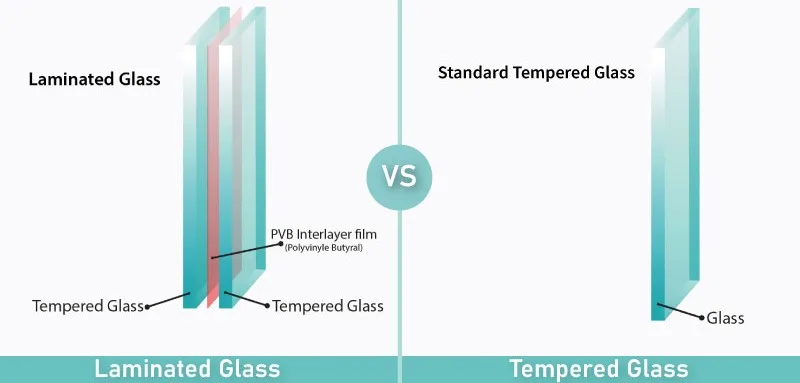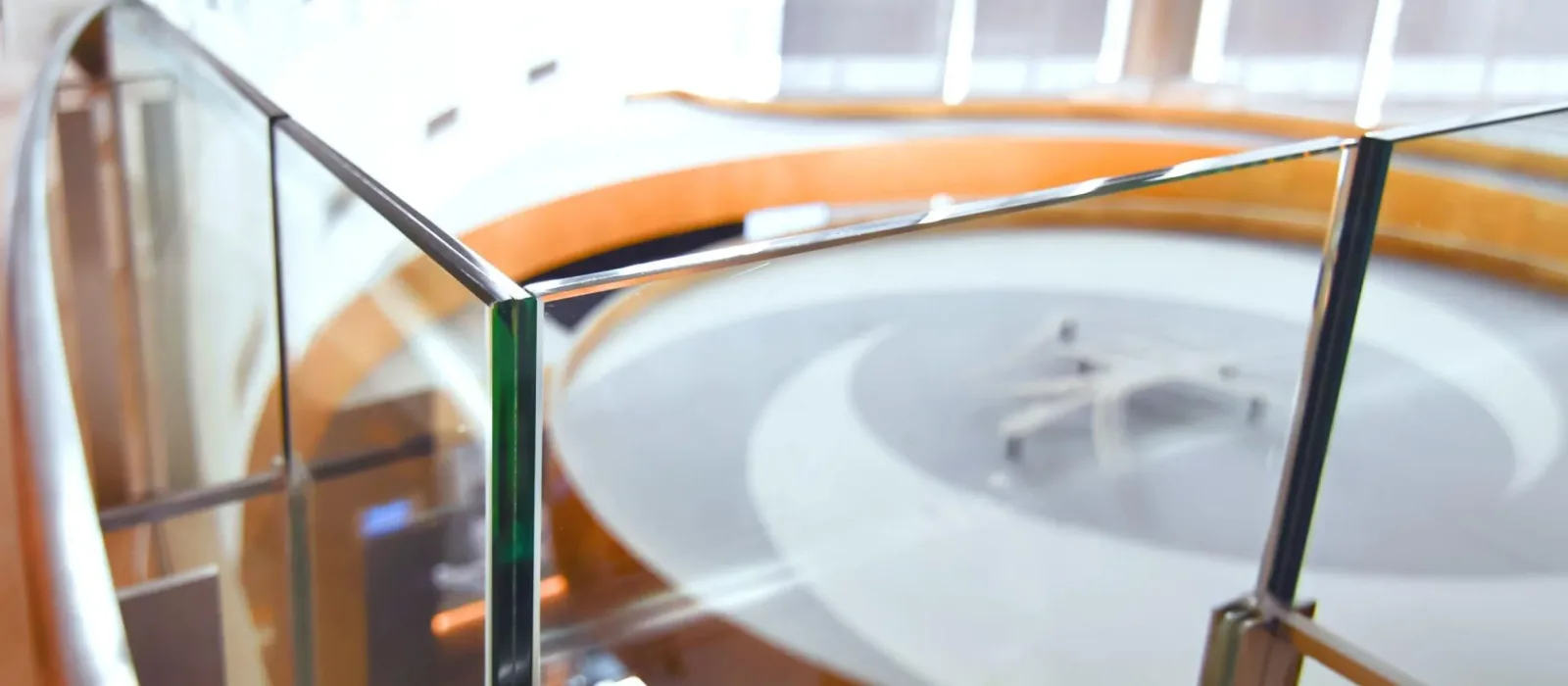Glass is no longer just a see-through material used for windows. It plays a vital role in architecture, safety, design, and energy efficiency — especially in both residential and commercial projects. Two of the most common types of safety glass used today are tempered glass and laminated glass.
But what exactly is the difference between these two? And more importantly — when should you use each one?
This guide breaks down the key differences, advantages, and ideal applications of tempered and laminated glass so you can make an informed choice for your next project.

What Is Tempered Glass?
Tempered glass — often referred to as toughened glass — is created through a thermal or chemical process that increases its strength compared to standard (annealed) glass.
🔧 How It’s Made:
- Heated to over 600°C (1112°F) and then rapidly cooled
- This process compresses the surface and creates internal tension
✅ Key Characteristics:
- 4–5 times stronger than regular glass
- Shatters into small, blunt pieces for safety
- Resistant to heat, impact, and thermal stress
📌 Common Uses:
- Glass shower enclosures
- Sliding doors and patio doors
- Interior partitions and railings
- Commercial windows and storefronts
- Car side and rear windows
What Is Laminated Glass?
Laminated glass consists of two or more layers of glass with a plastic interlayer (typically PVB or EVA) sandwiched in between. The layers are bonded using heat and pressure, resulting in a strong, durable material.
🔧 How It’s Made:
- Two sheets of glass + interlayer → sealed under heat and pressure
- The interlayer holds the glass together if it breaks
✅ Key Characteristics:
- Holds together when shattered (doesn’t fall apart)
- Provides sound insulation
- Offers UV protection
- Can remain intact even after breakage, offering continued security
📌 Common Uses:
- Windshields in vehicles
- Skylights
- Glass floors and staircases
- Overhead glazing and canopies
- Security or burglar-resistant windows
- Hurricane or impact-rated windows
Tempered vs. Laminated Glass: Side-by-Side Comparison
| Feature | Tempered Glass | Laminated Glass |
|---|---|---|
| Strength | High (impact-resistant) | Moderate to high |
| Breakage Behavior | Shatters into small pieces | Cracks but stays intact |
| Safety Rating | Excellent for physical safety | Excellent for intrusion prevention |
| Sound Insulation | Minimal | Good |
| UV Protection | Minimal | High (with interlayer) |
| Cost | Generally lower | Typically higher |
| Customization | Less customizable after tempering | Easy to laminate decorative films |
Which One Should You Use — and When?
The choice between tempered and laminated glass depends on your priorities: impact resistance, security, noise reduction, or design flexibility.
✔ Use Tempered Glass When:
- You need a high-impact resistant solution
Tempered glass is ideal for places with frequent physical contact, such as shower doors, glass railings, sliding doors, or glass partitions. Its ability to handle sudden force without breaking into sharp fragments makes it a safer option in these scenarios. - Thermal stress is a concern
Areas exposed to fluctuating temperatures, like exterior windows, kitchen backsplashes, or bathroom installations, benefit from tempered glass because it resists expansion and cracking from heat. - You want minimal visual obstruction
Tempered glass is often used when a sleek, frameless design is desired. Its clean edges and ability to hold polish make it a favorite for modern, open-concept interiors. - You want a more cost-effective safety glass
If budget is a concern, tempered glass is generally more affordable than laminated alternatives while still meeting safety standards in many residential and commercial applications.
✔ Use Laminated Glass When:
- Security is a top priority
Laminated glass doesn’t fall apart when broken — the interlayer keeps the pieces in place, making it much harder to penetrate. This makes it ideal for storefronts, windows in ground-floor homes, and offices requiring added security. - Sound insulation is needed
Thanks to the interlayer, laminated glass reduces noise transmission significantly better than tempered glass. Use it in urban environments, near highways, or in shared office spaces where quiet matters. - UV protection or solar control is desired
Laminated glass can be manufactured with UV-blocking and solar-control interlayers, helping protect furniture, flooring, and artwork from fading. It’s a smart choice for skylights, sunrooms, and large windows. - Overhead or high-risk glazing is required
For canopies, glass floors, railings on balconies, or anywhere falling glass could pose a danger, laminated glass ensures that even if the panel cracks, it remains intact — reducing the risk of injury or property damage. - You want decorative or privacy options
Laminated glass can incorporate fabrics, tints, patterns, or even metal meshes within the interlayer. This makes it perfect for interior partitions, privacy screens, or artistic installations.
✅ Real-World Scenarios
| Project Type | Recommended Glass Type | Why |
|---|---|---|
| Frameless shower | Tempered | High strength, clean lines, water resistance |
| Storefront window | Laminated | Security, sound dampening, UV protection |
| Balcony railing | Laminated or Tempered-Laminated | Safety over height, weather resistance |
| Office partition | Tempered | Modern look, transparency, durability |
| Residential skylight | Laminated | Fall protection, UV filtering |
| Car windshield | Laminated | Holds together upon impact |
| Car side windows | Tempered | Shatters safely in accidents |
Frequently Asked Questions About Tempered and Laminated Glass
❓ Can laminated glass break?
Yes, laminated glass can crack or break under force, but the key difference is that the interlayer holds the glass pieces together, preventing it from shattering into dangerous shards. This makes it ideal for security applications and overhead glazing.
❓ Is tempered glass more expensive than laminated glass?
In general, tempered glass is less expensive than laminated glass. However, the price may vary depending on the thickness, size, and customization required. Laminated glass involves additional materials and manufacturing steps, which typically increase the cost.
❓ Can I use laminated glass for a frameless shower door?
Technically yes, but tempered glass is more commonly used for frameless shower doors due to its strength, resistance to thermal stress, and clean, edge-polished finish. Laminated glass tends to be more appropriate for windows, railings, or security features rather than areas with constant water exposure.
❓ What type of glass is best for soundproofing?
Laminated glass is better for sound insulation because the interlayer helps block and dampen sound waves. It’s a popular choice for urban residences, recording studios, and commercial offices seeking peace and quiet.
Make the Right Glass Choice for Your Project
Choosing between tempered and laminated glass doesn’t have to be complicated. By understanding their core differences — from how they break to how they perform under stress — you can make an informed, safe, and stylish decision for your space.
And when you’re working with custom sizes, finishes, or applications, it’s always best to consult with an expert.
📞 Looking for professional advice or installation in Ontario? Zenith Glass offers tailored glass solutions with high-quality materials, precision craftsmanship, and friendly guidance every step of the way.

